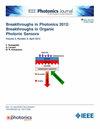Deep Learning-Based Cascaded Light Source Detection for Link Alignment in Underwater Wireless Optical Communication
IF 2.1
4区 工程技术
Q3 ENGINEERING, ELECTRICAL & ELECTRONIC
引用次数: 0
Abstract
Obtaining the light source position from the image is an important solution for achieving link alignment in laser-based underwater wireless optical communication (UWOC) systems. However, in practical scenarios, the misalignment degree between the light source and camera is variable, and factors such as ambient light may introduce disturbances, leading to significant variations in the appearance of light spots in images. Existing research primarily relies on simple features like brightness, color, or shape, which makes it difficult to accurately obtain position information from these non-ideal images. In this paper, deep neural networks (DNNs) with strong feature extraction capabilities are introduced to automatically learn the patterns of the light source from diverse images. A detection architecture cascading an object detector and a keypoint detector is adopted, achieving better comprehensive performance in terms of accuracy and speed. To train and evaluate the deep learning model, we construct the UWOC Light Source Detection Benchmark (ULDB) dataset. This dataset comprises 2200 images captured in a standard swimming pool, covering a misalignment range far beyond existing studies. On the ULDB test set, the proposed detection method achieves an average precision (AP) of 99.1% and an average positioning error of 4.66 pixels, while the traditional method may frequently extract false light spots. To the best of our knowledge, the ULDB dataset is the first image dataset specifically designed for the task of link alignment between UWOC terminals.基于深度学习的级联光源检测,用于水下无线光通信中的链路对准
在基于激光的水下无线光通信(UWOC)系统中,从图像中获取光源位置是实现链路对准的重要解决方案。然而,在实际应用场景中,光源与摄像头之间的错位程度是不固定的,而且环境光等因素可能会带来干扰,从而导致图像中光点的外观变化很大。现有研究主要依赖亮度、颜色或形状等简单特征,很难从这些非理想图像中准确获取位置信息。本文引入了具有强大特征提取能力的深度神经网络(DNN),从不同的图像中自动学习光源的模式。本文采用了一种级联对象检测器和关键点检测器的检测架构,在准确性和速度方面实现了更好的综合性能。为了训练和评估深度学习模型,我们构建了 UWOC 光源检测基准(ULDB)数据集。该数据集包括在标准游泳池中捕获的 2200 张图像,涵盖的错位范围远远超出了现有研究的范围。在 ULDB 测试集上,所提出的检测方法的平均精度(AP)达到 99.1%,平均定位误差为 4.66 像素,而传统方法可能会经常提取到错误光点。据我们所知,ULDB 数据集是第一个专门针对 UWOC 终端之间链路对齐任务而设计的图像数据集。
本文章由计算机程序翻译,如有差异,请以英文原文为准。
求助全文
约1分钟内获得全文
求助全文
来源期刊

IEEE Photonics Journal
ENGINEERING, ELECTRICAL & ELECTRONIC-OPTICS
CiteScore
4.50
自引率
8.30%
发文量
489
审稿时长
1.4 months
期刊介绍:
Breakthroughs in the generation of light and in its control and utilization have given rise to the field of Photonics, a rapidly expanding area of science and technology with major technological and economic impact. Photonics integrates quantum electronics and optics to accelerate progress in the generation of novel photon sources and in their utilization in emerging applications at the micro and nano scales spanning from the far-infrared/THz to the x-ray region of the electromagnetic spectrum. IEEE Photonics Journal is an online-only journal dedicated to the rapid disclosure of top-quality peer-reviewed research at the forefront of all areas of photonics. Contributions addressing issues ranging from fundamental understanding to emerging technologies and applications are within the scope of the Journal. The Journal includes topics in: Photon sources from far infrared to X-rays, Photonics materials and engineered photonic structures, Integrated optics and optoelectronic, Ultrafast, attosecond, high field and short wavelength photonics, Biophotonics, including DNA photonics, Nanophotonics, Magnetophotonics, Fundamentals of light propagation and interaction; nonlinear effects, Optical data storage, Fiber optics and optical communications devices, systems, and technologies, Micro Opto Electro Mechanical Systems (MOEMS), Microwave photonics, Optical Sensors.
 求助内容:
求助内容: 应助结果提醒方式:
应助结果提醒方式:


